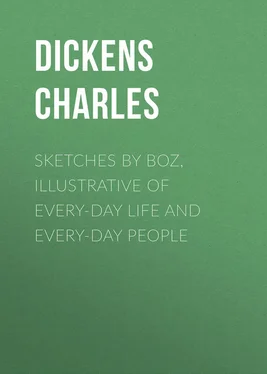Чарльз Диккенс - Sketches by Boz, Illustrative of Every-Day Life and Every-Day People
Здесь есть возможность читать онлайн «Чарльз Диккенс - Sketches by Boz, Illustrative of Every-Day Life and Every-Day People» — ознакомительный отрывок электронной книги совершенно бесплатно, а после прочтения отрывка купить полную версию. В некоторых случаях можно слушать аудио, скачать через торрент в формате fb2 и присутствует краткое содержание. Жанр: foreign_antique, foreign_prose, на английском языке. Описание произведения, (предисловие) а так же отзывы посетителей доступны на портале библиотеки ЛибКат.
- Название:Sketches by Boz, Illustrative of Every-Day Life and Every-Day People
- Автор:
- Жанр:
- Год:неизвестен
- ISBN:нет данных
- Рейтинг книги:3 / 5. Голосов: 1
-
Избранное:Добавить в избранное
- Отзывы:
-
Ваша оценка:
- 60
- 1
- 2
- 3
- 4
- 5
Sketches by Boz, Illustrative of Every-Day Life and Every-Day People: краткое содержание, описание и аннотация
Предлагаем к чтению аннотацию, описание, краткое содержание или предисловие (зависит от того, что написал сам автор книги «Sketches by Boz, Illustrative of Every-Day Life and Every-Day People»). Если вы не нашли необходимую информацию о книге — напишите в комментариях, мы постараемся отыскать её.
Sketches by Boz, Illustrative of Every-Day Life and Every-Day People — читать онлайн ознакомительный отрывок
Ниже представлен текст книги, разбитый по страницам. Система сохранения места последней прочитанной страницы, позволяет с удобством читать онлайн бесплатно книгу «Sketches by Boz, Illustrative of Every-Day Life and Every-Day People», без необходимости каждый раз заново искать на чём Вы остановились. Поставьте закладку, и сможете в любой момент перейти на страницу, на которой закончили чтение.
Интервал:
Закладка:
We took a step or two further on, and by way of restoring the naturally cheerful tone of our thoughts, began fitting visionary feet and legs into a cellar-board full of boots and shoes, with a speed and accuracy that would have astonished the most expert artist in leather, living. There was one pair of boots in particular – a jolly, good-tempered, hearty-looking pair of tops, that excited our warmest regard; and we had got a fine, red-faced, jovial fellow of a market-gardener into them, before we had made their acquaintance half a minute. They were just the very thing for him. There was his huge fat legs bulging over the tops, and fitting them too tight to admit of his tucking in the loops he had pulled them on by; and his knee-cords with an interval of stocking; and his blue apron tucked up round his waist; and his red neckerchief and blue coat, and a white hat stuck on one side of his head; and there he stood with a broad grin on his great red face, whistling away, as if any other idea but that of being happy and comfortable had never entered his brain.
This was the very man after our own heart; we knew all about him; we had seen him coming up to Covent-garden in his green chaise-cart, with the fat, tubby little horse, half a thousand times; and even while we cast an affectionate look upon his boots, at that instant, the form of a coquettish servant-maid suddenly sprung into a pair of Denmark satin shoes that stood beside them, and we at once recognised the very girl who accepted his offer of a ride, just on this side the Hammersmith suspension-bridge, the very last Tuesday morning we rode into town from Richmond.
A very smart female, in a showy bonnet, stepped into a pair of grey cloth boots, with black fringe and binding, that were studiously pointing out their toes on the other side of the top-boots, and seemed very anxious to engage his attention, but we didn’t observe that our friend the market-gardener appeared at all captivated with these blandishments; for beyond giving a knowing wink when they first began, as if to imply that he quite understood their end and object, he took no further notice of them. His indifference, however, was amply recompensed by the excessive gallantry of a very old gentleman with a silver-headed stick, who tottered into a pair of large list shoes, that were standing in one corner of the board, and indulged in a variety of gestures expressive of his admiration of the lady in the cloth boots, to the immeasurable amusement of a young fellow we put into a pair of long-quartered pumps, who we thought would have split the coat that slid down to meet him, with laughing.
We had been looking on at this little pantomime with great satisfaction for some time, when, to our unspeakable astonishment, we perceived that the whole of the characters, including a numerous corps de ballet of boots and shoes in the background, into which we had been hastily thrusting as many feet as we could press into the service, were arranging themselves in order for dancing; and some music striking up at the moment, to it they went without delay. It was perfectly delightful to witness the agility of the market-gardener. Out went the boots, first on one side, then on the other, then cutting, then shuffling, then setting to the Denmark satins, then advancing, then retreating, then going round, and then repeating the whole of the evolutions again, without appearing to suffer in the least from the violence of the exercise.
Nor were the Denmark satins a bit behindhand, for they jumped and bounded about, in all directions; and though they were neither so regular, nor so true to the time as the cloth boots, still, as they seemed to do it from the heart, and to enjoy it more, we candidly confess that we preferred their style of dancing to the other. But the old gentleman in the list shoes was the most amusing object in the whole party; for, besides his grotesque attempts to appear youthful, and amorous, which were sufficiently entertaining in themselves, the young fellow in the pumps managed so artfully that every time the old gentleman advanced to salute the lady in the cloth boots, he trod with his whole weight on the old fellow’s toes, which made him roar with anguish, and rendered all the others like to die of laughing.
We were in the full enjoyment of these festivities when we heard a shrill, and by no means musical voice, exclaim, ‘Hope you’ll know me agin, imperence!’ and on looking intently forward to see from whence the sound came, we found that it proceeded, not from the young lady in the cloth boots, as we had at first been inclined to suppose, but from a bulky lady of elderly appearance who was seated in a chair at the head of the cellar-steps, apparently for the purpose of superintending the sale of the articles arranged there.
A barrel-organ, which had been in full force close behind us, ceased playing; the people we had been fitting into the shoes and boots took to flight at the interruption; and as we were conscious that in the depth of our meditations we might have been rudely staring at the old lady for half an hour without knowing it, we took to flight too, and were soon immersed in the deepest obscurity of the adjacent ‘Dials.’
CHAPTER VII – HACKNEY-COACH STANDS
We maintain that hackney-coaches, properly so called, belong solely to the metropolis. We may be told, that there are hackney-coach stands in Edinburgh; and not to go quite so far for a contradiction to our position, we may be reminded that Liverpool, Manchester, ‘and other large towns’ (as the Parliamentary phrase goes), have their hackney-coach stands. We readily concede to these places the possession of certain vehicles, which may look almost as dirty, and even go almost as slowly, as London hackney-coaches; but that they have the slightest claim to compete with the metropolis, either in point of stands, drivers, or cattle, we indignantly deny.
Take a regular, ponderous, rickety, London hackney-coach of the old school, and let any man have the boldness to assert, if he can, that he ever beheld any object on the face of the earth which at all resembles it, unless, indeed, it were another hackney-coach of the same date. We have recently observed on certain stands, and we say it with deep regret, rather dapper green chariots, and coaches of polished yellow, with four wheels of the same colour as the coach, whereas it is perfectly notorious to every one who has studied the subject, that every wheel ought to be of a different colour, and a different size. These are innovations, and, like other miscalled improvements, awful signs of the restlessness of the public mind, and the little respect paid to our time-honoured institutions. Why should hackney-coaches be clean? Our ancestors found them dirty, and left them so. Why should we, with a feverish wish to ‘keep moving,’ desire to roll along at the rate of six miles an hour, while they were content to rumble over the stones at four? These are solemn considerations. Hackney-coaches are part and parcel of the law of the land; they were settled by the Legislature; plated and numbered by the wisdom of Parliament.
Then why have they been swamped by cabs and omnibuses? Or why should people be allowed to ride quickly for eightpence a mile, after Parliament had come to the solemn decision that they should pay a shilling a mile for riding slowly? We pause for a reply; – and, having no chance of getting one, begin a fresh paragraph.
Our acquaintance with hackney-coach stands is of long standing. We are a walking book of fares, feeling ourselves, half bound, as it were, to be always in the right on contested points. We know all the regular watermen within three miles of Covent-garden by sight, and should be almost tempted to believe that all the hackney-coach horses in that district knew us by sight too, if one-half of them were not blind. We take great interest in hackney-coaches, but we seldom drive, having a knack of turning ourselves over when we attempt to do so. We are as great friends to horses, hackney-coach and otherwise, as the renowned Mr. Martin, of costermonger notoriety, and yet we never ride. We keep no horse, but a clothes-horse; enjoy no saddle so much as a saddle of mutton; and, following our own inclinations, have never followed the hounds. Leaving these fleeter means of getting over the ground, or of depositing oneself upon it, to those who like them, by hackney-coach stands we take our stand.
Читать дальшеИнтервал:
Закладка:
Похожие книги на «Sketches by Boz, Illustrative of Every-Day Life and Every-Day People»
Представляем Вашему вниманию похожие книги на «Sketches by Boz, Illustrative of Every-Day Life and Every-Day People» списком для выбора. Мы отобрали схожую по названию и смыслу литературу в надежде предоставить читателям больше вариантов отыскать новые, интересные, ещё непрочитанные произведения.
Обсуждение, отзывы о книге «Sketches by Boz, Illustrative of Every-Day Life and Every-Day People» и просто собственные мнения читателей. Оставьте ваши комментарии, напишите, что Вы думаете о произведении, его смысле или главных героях. Укажите что конкретно понравилось, а что нет, и почему Вы так считаете.












